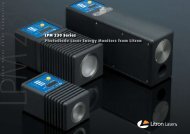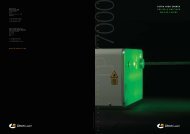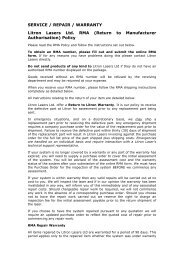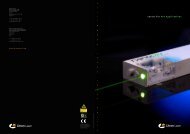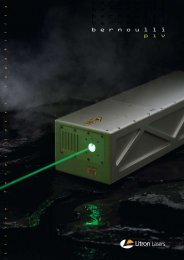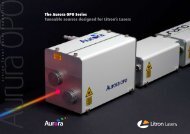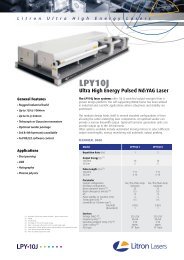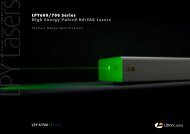Comparison of Beam Divergence, Beam Diameter ... - Litron Lasers
Comparison of Beam Divergence, Beam Diameter ... - Litron Lasers
Comparison of Beam Divergence, Beam Diameter ... - Litron Lasers
Create successful ePaper yourself
Turn your PDF publications into a flip-book with our unique Google optimized e-Paper software.
than 1 (the theoretical minimum) to several tens or even<br />
hundreds. Many practical applications require the lowest<br />
possible value.<br />
The optical set up depicted here can be used to measure<br />
both the beam divergence and the M 2 value <strong>of</strong> a real laser.<br />
A lens <strong>of</strong> focal length 1 or 2m is typically used, along with<br />
attenuation optics and the beam is imaged using a CCD<br />
and s<strong>of</strong>tware.<br />
Measuring the beam in the focal plane <strong>of</strong> the lens yields<br />
the beam’s ‘raw’ divergence, simply by dividing the beam<br />
diameter in the focal plane by the focal length. Since we<br />
only know for sure what the laser beam diameter is near<br />
its output aperture, this figure tells us little about the beam<br />
quality. We do not know the position <strong>of</strong> the waist <strong>of</strong> the<br />
original laser beam or its size. In many real lasers, it can<br />
be located behind the laser (or sometimes well in front <strong>of</strong><br />
it) and is thus <strong>of</strong>ten smaller than the laser beam diameter<br />
measured at its output aperture. Only the true waist<br />
diameter can be combined with the divergence to give M 2 .<br />
By looking in the vicinity <strong>of</strong> the focal plane for a minimum<br />
diameter spot, the waist as transformed by the lens, we<br />
can gain much more useful information. For real lasers, the<br />
waist is usually located near the focal plane and usually a<br />
little way after it. Note that the original beam divergence is<br />
eliminated in the expression that gives M 2 . It is expressed<br />
in terms <strong>of</strong> the beam diameter at the waist, the diameter<br />
<strong>of</strong> the beam at the lens and the distance <strong>of</strong> the waist from<br />
the lens. All these parameters are relatively easily<br />
measured. The focal length <strong>of</strong> the lens and the beam<br />
diameter at the lens need to be chosen such that the waist<br />
is much smaller than the beam diameter at the lens.<br />
Technically speaking, to achieve accurate measurements,<br />
the waist must be much greater than its Rayleigh range<br />
from the lens. This value is given by πd 2 0 /4λM 2 .<br />
<strong>Beam</strong> <strong>Divergence</strong>: Irreducible and Reducible<br />
In the discussion above, the beam divergence as measured<br />
in the focal plane <strong>of</strong> our lens frequently contains some<br />
reducible elements. These can include sphericity imposed<br />
by lensing in an amplifier after the rod (and not fully<br />
compensated by the beam expanding telescope) or<br />
sphericity resulting from improper collimation <strong>of</strong> an<br />
unstable resonator; with a fixed length and a finite<br />
number <strong>of</strong> resonator mirror curvatures, it is <strong>of</strong>ten<br />
impossible to achieve perfect collimation. With proper<br />
beam control after the laser, such as the transmitting optics<br />
in a LIDAR system, or the focusing lens in a machining<br />
head, this sphericity can be eliminated and the irreducible<br />
element, as predicted by M 2 , will determine respectively<br />
the angular resolution <strong>of</strong> the LIDAR system or the spot size<br />
at a work piece.<br />
In some cases, our waist will be located in the focal plane<br />
<strong>of</strong> the lens. Only then can we say that the laser is truly<br />
collimated and only then can the aperture – divergence<br />
product be used to determine the beam quality. In many<br />
practical cases, this does not hold true.<br />
The irreducible divergence (full angle) is given by the<br />
expression 4M 2 λ/πd where d is the diameter <strong>of</strong> the laser<br />
beam measured at its waist. For reasons given above,<br />
this figure is <strong>of</strong>ten lower than the ‘raw’ divergence <strong>of</strong> the<br />
laser beam itself. To a first order approximation, the above<br />
expression holds true even if the laser beam is expanded<br />
or reduced by telescopes and the like.<br />
For more information contact: <strong>Litron</strong> <strong>Lasers</strong><br />
Email: sales@litronlasers.com<br />
<strong>Litron</strong> <strong>Lasers</strong> Ltd<br />
8 Consul Road,<br />
Rugby, Warwickshire<br />
CV21 1PB England<br />
Tel +44 (0)1788 574444<br />
Fax +44 (0)1788 574888<br />
<strong>Litron</strong> <strong>Lasers</strong> North America<br />
2449 Arnica Drive,<br />
Bozeman,<br />
MT 59715 USA<br />
T +1 (406) 522 7566<br />
F +1 (406) 522 7567<br />
www.litronlasers.com<br />
PB0115:1





